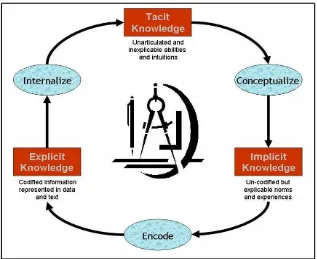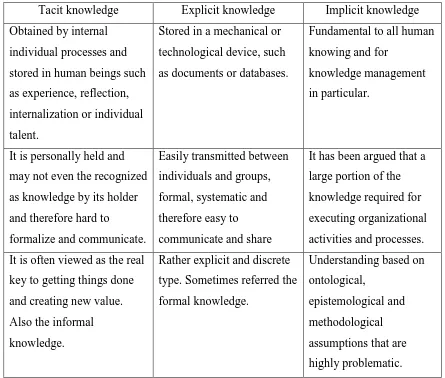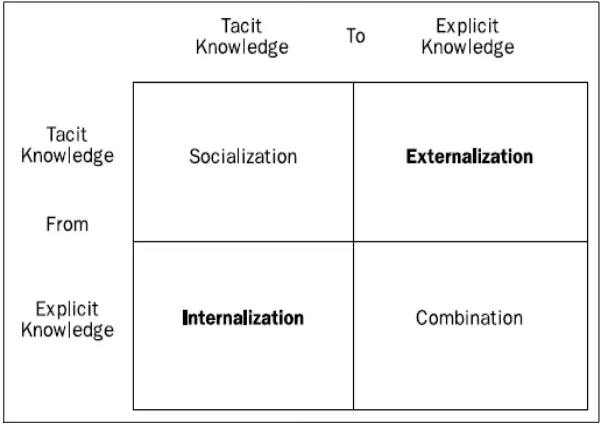UNIVERSITI TEKNIKAL MALAYSIA MELAKA
Knowledge Management in Manufacturing
Industry
Thesis submitted in accordance with the partial requirements of the Universiti Teknikal Malaysia Melaka
for the Bachelor of Manufacturing Engineering (Manufacturing Process)
By
Nurul Huda Bt Muhammad
Faculty of Manufacturing Engineering
APPROVAL
This thesis submitted to the senate of KUTKM and has been accepted as partial fulfillment of the requirements for the degree of Bachelor of Manufacturing Engineering
(Manufacturing Process). The members of the supervisory committee are as follow:
………. En. Muhammad Hafidz Fazli bin Md Fauadi
DECLARATION
“I hereby declare that this report and its entire contents is my own work unless specific reference and figure are made in the text. This work is submitted in partially fulfillment of the Bachelor in Manufacturing Process and has not been
submitted for any other qualification in any other institute.
Signature : ………..
Author’s Name : ………..
ABSTRACT
ABSTRAK
DEDICATION
For my beloved parents and my younger sister and brother.
ACKNOWLEDGEMENT
It would be impossible to more than scratch the surface in the form of knowledgements to the many individual who have helped me through the semester. However, some have contributed so much that their names literally jump off pages of my life and demond recognition.
I would like to take this opportunity to thank God for enabling me to undertake this Bachelor of Manufacturing Engineering and for granting me the strength, and wisdom to face and overcome all the challenges during the entire Bachelor programmed.
The past one year have been overwhelming and I could not have through it without the help of the people I want to thank right here. To my supervisors Mr. Hafidz Fazli bin Md. Fauadi and Prof. Madya Dr. Zolkepli Buang for giving me ample guidance and for always making time for me each time needed help. To other lecture in UTeM and are whose advice, help, encouragement and belief in me was vitally important in furthering my career.
My parents and siblings, through their living examples of faith, courage, common sense and love gave the foundation for life. To my friends especially Precilla Slyvester, Siti Sahara and Siti Saudah thank for invaluable help me to accomplish this project.
LIST OF CONTENTS
1.1 Background of Project………...……….………..…..2
1.2 Objectives of Project……….…....….2
1.3 Scopes of Project……….………….……..3
1.4 Problem Statement.……….…..….…….3
2.0 LITERATURE REVIEW……….……...…..…4
2.1 History of Knowledge Management……….……..……...4
2.2 Types of Knowledge………..……….…..……….6
2.2.1 Knowledge in an Organization……….…...9
2.3 Introduction of Management……….……….…….….10
2.3.1 The Function of Management…………..………..…10
2.4 Introduction of Knowledge Management………...11
2.4.1 Definition of Knowledge Management………...………...…13
2.4.2 Framework for Knowledge Management………..….14
2.4.3 The importance of Knowledge Management………..…...17
2.4.4 Needs for Knowledge Management……….…..18
2.5 Knowledge flow in Knowledge Management……….19
2.6 Knowledge Management Implementation……….……….21
2.6.1 Introduction……….………..22
2.6.2 Knowledge Value Chain……….………..23
2.6.3 Strategic Planning for Knowledge Management……….……….24
2.6.4 Typical Stages of a Manufacturing Process……….….25
2.7 Previous Development of KM………..…….….26
2.7.1 Knowledge Management for Manufacturing in the Product and Process………...27
2.7.2 Knowledge Management for Project………30
2.7.3 Knowledge Management for Manufacturing Organization……….32
2.8 Application of The Integrated DEFinition (IDEF)……….………...33
2.8.1 The IDEF Family of Method………...34
2.8.2 Use in Operational Setting………...36
2.8.3 Info Architecture………..37
2.9 Conclusion……….….38
3.0 METHODOLOGY...39
3.1 Gantt Chart……….………39
3.2 Process Planning……….……….…...40
3.3 Interview……….……...43
3.4 Conclusion………...43
4.0 COMPANY BACKGROUND………..…....44
4.1 Background of Tioxide(M) Malaysia Sdn.Bhd……….…....44
4.1.1 Tioxide Group of Company………..…...44
4.1.2Tioxide (Malaysia) Sdn. Bhd……….….……..…....45
4.1.3Tioxide (Malaysia) Organization………..…....47
4.2 Types of Final Product………..……….….….….…49
4.2.2R-FC 5………....50
4.3 The Manufacture of Titanium Dioxide Pigments………..….50
4.3.1Titanium Dioxide Properties………..……...52
4.3.2The Manufacturing Process………..……….…53
4.4 Conclusion………...…..54
5.0 ANALYSIS………..……....56
5.1 Engineering Department………...………..57
5.1.1 Reliability Manufacturing………...57
5.1.1.1 RBM Team………..…...……....58
5.1.1.2Refurbishment Team………...……….58
5.1.1.3Fabrication Team……….………...….58
5.1.2 Central Engineering Team………...58
5.1.3 Civil……….….60
5.2 Process Department……….…...60
5.2.1 Black End………..………...62
5.2.2 White End………..…...67
5.3 Types of Maintenance………..………..70
5.4 Conclusion……….……….82
6.0 DISCUSSION……….….83
6.1Interaction and Inter-relationship Engineering Department and Process Department……….…….….88
7.0 CONCLUSION...99
7.1 Issue during Project undertaken………..93
7.2 Recommendation….………..…..93
APPENDICES
A Gantt Chart
B Examples Question for Interview
LIST OF FIGURES
2.1 Knowledge Culture between Tacit, Explicit and Implicit Knowledge 6 2.2 Four Different Ways of Knowledge Conversion Model 8
2.3 Model of Management 11
2.4 Knowledge Management Framework 16
2.5 The Knowledge Circle within Knowledge Management 19
2.6 Knowledge Management G-spot 22
2.7 Knowledge Value Chain 23
2.8 Operating Models and KM Systems for Value-addition to Value 25 Proposition
2.9 Structure and Relations of the Product and Process Model 27 2.10 Model of Knowledge Management Analysis 28
2.11a Knowledge Creation Process 29
2.11b Knowledge Transfer Process 29
2.11c Knowledge Embedding Process 30
2.12 Characteristics of Information and Types and Sources of Information 31 2.13 Five tier Knowledge Management Hierarchy 31
2.14 The Three-tier Framework 32
2.15 An IDEF Model 37
2.20 Hierarchical View of IDEF0 Modeling 38
3.1 Flow Chart of Project Methodology 42
4.1 Location of Huntsman Tioxide 45
4.2 Teluk Kalong Site 46
4.3 The Division Location 47
4.6 Titanium Dioxide Process and Co-product 51 4.7 The Overall Process in Producing Titanium Dioxide 55
5.1 The Division of Engineering Department 57
5.2 Division of Reliability Manufacturing 57
5.3 Division of Central Engineering Team 59
5.4 Division of Civil Section 60
5.5 Division of Process Department 61
5.6 The Section at Black End 66
5.7 The Section at White End 69
5.8 Base of the Modeling Aspects of a System 73
5.9 Division for each Section 74
5.10 Reliability Manufacturing Section 75
5.11 Central Engineering Team (Mechanical) 76
5.12 Central Engineering Team (Electrical and Instrument) 77
5.13 Civil Section 78
5.14 Black End Section 79
5.15 White End System 80
5.16 Data Modeling 81
LIST OF TABLES
2.1 Comparison between Tacit, Explicit and Implicit Knowledge 7
2.2 Types of Knowledge 9
2.3 Overview of the Three Epistemologies 33
2.4 Suite of IDEF Method 36
LIST OF ABBREVIATIONS, SYMBOLS, SPECIALIZED
NOMENCLATURE
APQC - American Productivity and Quality Council ASIS - American Society for Information Science BPE - Business Process Engineering
BPR - Business Process Reengineering DCS - Distributed Control System IDEF - Integrated DEFinition
IKMN - The International Knowledge Management Network IT - Information Technology
KM - Knowledge Management
OSTD - Object Static Transition Description PFD - Process Flow Description
RBM - Reliability Based Maintenance
LIST OF APPENDICES
APPENDIX A - Gantt Chart
APPENDIX B - Examples Question for Interview APPENDIX C - Organization Chart
CHAPTER 1
INTRODUCTION
1.1 Background of project
This project is intended about the implementation and practices of knowledge management in industry. Knowledge Management is getting the right information to the right people at the right time, and helping people create knowledge and share and act upon information. This project starts from the system level to the functional level and their arrangement organization.
Knowledge can lead to innovation, improvement of business processes and overall business performance. But knowledge is often not explicit and in many cases captured in the minds of experts, making it very hard to distribute it throughout the organization. The last decade knowledge has become more and more important for businesses. Acknowledging the importance of knowledge however is not enough; it is much more important to be capable of managing this knowledge.
received much interest since the 1990’s and has led to large investments by many knowledge intensive firms
Some processes have very critical product specifications, especially as regards the permissibility of contaminants, and an understanding of how to manage the production process accordingly is essential to success in designing and building such as plant. A plant which is designed to produce pigment as a food requires different considerations from a plant which produces pigment as an industrial chemical
The final fundamental concept that needs to be addressed is that process. A process is a set of usually sequential value added tasks that use organizational resourse to produce a product or service. A process can be unique to a single department or can cross many departments within an organization. A process is usually repetitive in nature and is needed to make product or achieve a result. The initial perception of processes may be that they are not complicated; that they can managed with relative ease and that arbitrary changes can be made to the process or make improvements
1.2 Objectives of Project
The purpose of this project is to study the implementation and practices of knowledge management in industry. The objective of this project is:
• To study the implementation and practices of knowledge management in manufacturing industry.
1.3 Scopes of Project
To ensure the objective is achieved, some of the important elements must be consideration. There is:
• This study was done at Hunstman Tioxide(M) Sdn.Bhd, Kemaman, Terengganu. • The point of view of this study starts from the system level to the fuctional level
(Product Flow)
• Framework for Knowledge Management implementation
• To study the interaction and inter-relation between Engineering Department and Process Department from Knowledge Management point of view
1.4 Problem Statement
The knowledge management (KM) is very important in the 2000’s because it helps organizations to gain competitive advantage and effective working through sharing and re-using knowledge. In the market place of e-business, KM initiatives are used to systematically leverage information and expertise to improve organizational responsiveness, innovation, competency and efficiency (RICE) (Lotus, 2001). There are many reasons why knowledge should be managed properly especially using the collaborative technology. Among these are information overload, technology advancement, increased professional specialization, competition, workforce mobility and turnover, and capitalization of organizational knowledge.
CHAPTER 2
LITERATURE REVIEW
2.1 History of knowledge management
Knowledge management (KM) has become an important strategy for improving organizational competitiveness and performance due to the fact that appropriate management and leveraging of knowledge can propel an organization to become more adaptive, innovative, intelligent and sustainable. An overarching theory of knowledge management has yet to emerge, perhaps because the practices associated with managing knowledge have their roots in a variety of disciplines and domains.
A number of management theorists have contributed to the evolution of knowledge management, among them such notables as Peter Drucker, Paul Strassmann, and Peter Senge in the United States. Drucker and Strassmann (2003) have stressed the growing importance of information and explicit knowledge as organizational resources, and Senge has focused on the "learning organization," a cultural dimension of managing knowledge.
others, and the first books on organizational learning and knowledge management were published (for example, Senge’s The Fifth Discipline and Sakaiya’s The Knowledge Value Revolution).
By 1990, a number of management consulting firms had begun in-house knowledge management programs, and several well known U.S., European, and Japanese firms had instituted focused knowledge management programs. Knowledge management was introduced in the popular press in 1991, when Tom Stewart published “Brainpower” in Fortune magazine. Perhaps the most widely read work to date is Ikujiro Nonaka’s and Hirotaka Takeuchi’s The Knowledge-Creating Company: How Japanese Companies Create the Dynamics of Innovation (1995).
2.2.1 Types of knowledge
By reading different definitions of knowledge it will soon become clear that knowledge is not very easy to define. It also comes in multiple forms. The main distinction between types of knowledge which is widely accepted is tacit, explicit and implicit (Nonaka and Takeuchi, 1995). The comparison of the three of knowledge can refer in the Table 2.2 and for knowledge culture interaction for three of this knowledge can be refer Figure 2.2
Table 2.1: Comparison between Tacit, Explicit and Implicit Knowledge
Tacit knowledge Explicit knowledge Implicit knowledge Obtained by internal
individual processes and stored in human beings such as experience, reflection, internalization or individual talent.
Stored in a mechanical or technological device, such as documents or databases.
Fundamental to all human knowing and for
knowledge management in particular.
It is personally held and may not even the recognized as knowledge by its holder and therefore hard to
formalize and communicate. large portion of the knowledge required for executing organizational activities and processes. It is often viewed as the real
key to getting things done and creating new value. Also the informal knowledge.
Rather explicit and discrete type. Sometimes referred the formal knowledge.
Nonaka and Takeuchi, 1995 also discussed four different ways in knowledge conversion model (Refer Figure 2.2). The elaborate of different ways of knowledge conversion model are:
ii. Tacit knowledge to explicit knowledge (externalization). It is a knowledge creation process in that tacit knowledge becomes explicit, taking the shapes of metaphors, analogies, concepts, hypotheses or models.
iii. Explicit knowledge to explicit knowledge (combination). It involves combining different bodies of explicit knowledge.
iv. Explicit knowledge to tacit knowledge (internalization). It is a process of embodying explicit knowledge into tacit knowledge and is closely related to ‘learning by doing’.
Figure 2.2: Four Different Ways of Knowledge Conversion Model (Nonaka and Takeuchi, 1995)
Using the framework Davenport and Prusak have come to a working definition of knowledge:
“Knowledge is a fluid mix of framed experiences, values, contextual information,
and expert insight that provides a framework for evaluating and incorporating new


